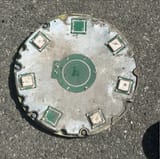Search Results
6/24/2025, 9:00:59 AM
Evolving Anti-Jamming Antennas in Russian Shahed Drones Reveal New Dependencies
1/?
A recent analysis by Ukrainian military radio technology expert Serhiy "Flash" Beskrestnov highlights the critical evolution of the navigation systems in Russian-operated Shahed-136 drones, focusing on the specialized antennas essential for countering Ukrainian electronic warfare (EW) measures. These antennas are the "heart" of the drone's electronics; without their ability to protect against jamming, the weapon cannot reach its designated target.
Beskrestnov, a prominent analyst of Russian military hardware, notes a clear progression in the Controlled Reception Pattern Antennas (CRPA) being used, which are designed to filter out spoofing or jamming signals. The effectiveness of these antennas is proportional to their complexity—the more individual elements they contain, the more robust their defense against EW.
Several distinct variants have been identified, indicating a shifting supply chain:
Iranian 4-Element Antennas: Early models used at the Alabuga assembly plant in Russia were sourced from Iran. These stocks have reportedly been depleted.
Russian "Kometa" Antennas: The Izhevsk plant produces a domestic CRPA known as the "Kometa," observed in both 8- and 12-element configurations. These are used not only in Shahed drones but also in guided bomb kits.[3]
Chinese 8-Element Antennas: To replace the depleted Iranian stock, the Alabuga plant has switched to 8-element antennas sourced from China.
High-End Variants: For high-value targets, a more powerful 16-element antenna is employed. Beskrestnov also notes that Iran has developed its own new 8-element antenna, which has appeared in novel Shahed variants equipped with AI-based systems, though these do not appear to be widely supplied to Russia.
1/?
A recent analysis by Ukrainian military radio technology expert Serhiy "Flash" Beskrestnov highlights the critical evolution of the navigation systems in Russian-operated Shahed-136 drones, focusing on the specialized antennas essential for countering Ukrainian electronic warfare (EW) measures. These antennas are the "heart" of the drone's electronics; without their ability to protect against jamming, the weapon cannot reach its designated target.
Beskrestnov, a prominent analyst of Russian military hardware, notes a clear progression in the Controlled Reception Pattern Antennas (CRPA) being used, which are designed to filter out spoofing or jamming signals. The effectiveness of these antennas is proportional to their complexity—the more individual elements they contain, the more robust their defense against EW.
Several distinct variants have been identified, indicating a shifting supply chain:
Iranian 4-Element Antennas: Early models used at the Alabuga assembly plant in Russia were sourced from Iran. These stocks have reportedly been depleted.
Russian "Kometa" Antennas: The Izhevsk plant produces a domestic CRPA known as the "Kometa," observed in both 8- and 12-element configurations. These are used not only in Shahed drones but also in guided bomb kits.[3]
Chinese 8-Element Antennas: To replace the depleted Iranian stock, the Alabuga plant has switched to 8-element antennas sourced from China.
High-End Variants: For high-value targets, a more powerful 16-element antenna is employed. Beskrestnov also notes that Iran has developed its own new 8-element antenna, which has appeared in novel Shahed variants equipped with AI-based systems, though these do not appear to be widely supplied to Russia.
Page 1
